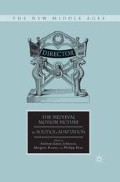Abstract
Not all is well in the Seven Kingdoms: The children of the king are not in fact the children of the king. As the closely guarded secret of their true parentage seeps out, the cogs and wheels of an unstoppable mechanism grind into motion that will plunge the realm into all-out civil war. The fragile political equilibrium in the fictional world of Westeros is destroyed, and what we get in return is George R. R. Martin’s multivolume series of novels A Song of Ice and Fire (1996 to present),1 HBO’s award-winning television adaptation of that epic saga, Game of Thrones (2011 to present),2 as well as a computer game of the same name (2012), and a steadily expanding range of associated merchandise. What, then, is the precise nature of the impetus that triggers this colossal narrative machine? As it transpires, the actual father of King Robert Baratheon’s official heirs is none other than Jaime Lannister, the queen’s twin brother.
I am particularly grateful to Andrew James Johnston and Margitta Rouse, whose helpful suggestions during the compositional stage of this chapter are much appreciated. Further thanks are due to Sven Duncan Durie, who provided perceptive criticism and encouragement at various junctures.
Access this chapter
Tax calculation will be finalised at checkout
Purchases are for personal use only
Preview
Unable to display preview. Download preview PDF.
Notes
Geraldine Heng, Empire of Magic. Medieval Romance and the Politics of Cultural Fantasy (New York: Columbia University Press, 2003), p. 2.
The show starts as a group of mounted men clad in furs and armed with swords emerge from the portcullis of what appears to be a kind of icy fortress, venturing out into a hostile winter forest where they discover a number of horribly mutilated corpses and have a thoroughly fatal encounter w ith zombiel i ke creat ures. A choice set of signs like crenel lated battlements, horses, coarse clothing, severed limbs and swords is sufficient to lend the scene a distinctly medieval air, although a closer look reveals that only the particular type of cross-guard-equipped sword that is shown could be said to be unique to certain parts of the historical period commonly referred to as the European Middle Ages. Other popular markers of the medieval in evidence here are bad teeth (Sarah Salih, “Cinematic Authenticity-Effects and Medieval Art: A Paradox,” in Medieval Film, ed. Anke Bernau and Bettina Bildhauer [Manchester: Manchester University Press, 2009], pp. 28–29 [20–39]) and filth, that classic litmus test of the attitude of a film or television series towards the Middle Ages
(Laurie A. Finke and Martin B. Shichtman, Cinematic Illuminations. The Middle Ages on Film [Baltimore, MD: Johns Hopkins University Press, 2010], p. 48). On the other hand, the scene also makes it abundantly clear that an exclusively “realist ic” port rayal of the Middle Ages is not for thcom ing, and that there is a strongly fantastic element to be reckoned with: Blue-eyed undead are hardly the stuff of history books.
Helen Cooper, The English Romance in Time. Transforming Motifs from Geoffrey of Monmouth to the Death of Shakespeare (Oxford: Oxford University Press, 2004), pp. 3–4.
Ibid., p. 9 [original emphasis]. Understood in these terms, it is unnecessary to discard the term romance as a heuristic tool, as Margaret Doody has suggested due to the derogatory connotations Bakhtinian orthodoxy attaches to it (Margaret Anne Doody, The True Story of the Novel [New Brunswick, NJ: Rutgers University Press, 1996], here esp. p. 15).
Jutta Eming, Claudia Jarzebowski, and Claudia Ulbrich, “Einleitung,” in Historische Inzestdiskurse, ed. Jutta Eming, Claudia Jarzebowski, and Claudia Ulbrich (Königstein/Taunus: Ulrike Helmer, 2003), here esp. p. 9 [9–20].
M. Victoria Guerin, The Fall of Kings and Princes. Structure and Destruction in Arthurian Tragedy (Stanford, CA: Stanford University Press, 1995), p. 9.
All three basic incestuous constellations suggested by Elizabeth Archibald can be encountered in Game of Thrones: mother-son incest, sibling incest, and father-daughter incest (Elizabeth Archibald, Incest and the Medieval Imagination [Oxford: Clarendon Press, 2001], here esp. p. 1).
Matilda Tomaryn Bruckner, “The Shape of Romance in Medieval France,” in The Cambridge Companion to Medieval Romance, ed. R. L. Krueger (Cambridge, UK: Cambridge University Press, 2000), p. 13 [13–28].
Game of Thrones seems to be right on the verge of making inroads into the territory of scholarly investigation. The only publication on the novels or the HBO series currently available is William Irwin and Henry Jacoby, eds., Game of Thrones and Philosophy. Logic Cuts Deeper Than Swords (Hoboken, NJ: Wiley, 2012). While equipped with a slender scholarly apparatus, the collection of essays with its focus on the accessible discussion of philosophical issues seems to be aimed predominantly at fans— the presence of a comprehensive spoiler warning after the foreword may be taken as an indicator of the intended audience.
Jutta Eming, “Inzestneigung und Inzestvollzug im mittelalterlichen Liebes- und Abenteuerroman (Mai und Beaflor und Apollonius von Tyrus),” in Historische Inzestdiskurse, ed. Jutta Eming, Claudia Jarzebowski, and Claudia Ulbrich (Königstein/Taunus: Ulrike Helmer, 2003), p. 26 [21–45];
Nickolas Haydock, Movie Medievalism. The Imaginary Middle Ages (Jefferson, NC: McFarland, 2008), p. 186.
See for example Linda Hutcheon, A Theory of Adaptation (New York: Routledge, 2006), p. xiii: “[T]he idea of ‘fidelity’ to that prior text is often what drives any directly comparative method of study.”
Andrew James Johnston, Performing the Middle Ages from Beowulf to Othello (Turnhout: Brepols, 2008), p. 170.
Editor information
Editors and Affiliations
Copyright information
© 2014 Andrew James Johnston, Margitta Rouse, and Philipp Hinz
About this chapter
Cite this chapter
Bleisteiner, M. (2014). Perils of Generation: Incest, Romance, and the Proliferation of Narrative in Game of Thrones. In: Johnston, A.J., Rouse, M., Hinz, P. (eds) The Medieval Motion Picture. The New Middle Ages. Palgrave Macmillan, New York. https://doi.org/10.1057/9781137074249_8
Download citation
DOI: https://doi.org/10.1057/9781137074249_8
Publisher Name: Palgrave Macmillan, New York
Print ISBN: 978-1-349-29443-5
Online ISBN: 978-1-137-07424-9
eBook Packages: Palgrave Media & Culture CollectionLiterature, Cultural and Media Studies (R0)

